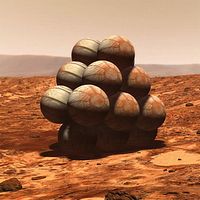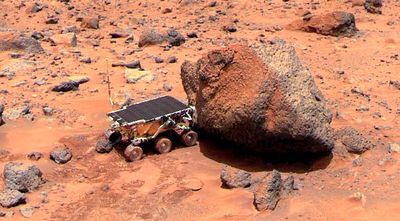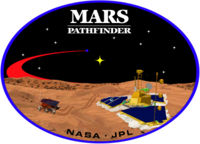Difference between revisions of "Mars Pathfinder"
m |
|||
| (14 intermediate revisions by one other user not shown) | |||
| Line 2: | Line 2: | ||
==Overview== | ==Overview== | ||
| − | |||
| − | + | This [[NASA]] mission was launched on a [[Delta II]] rocket on December 4, 1996. The '''Mars Pathfinder''' mission was used to demonstrate that [[NASA]] could send an exploratory mission to Mars for 1/15th of the cost of the [[Viking]] budget in the 1970's. The mission was developed at a cost of under $150 million in 3 years. Mars Pathfinder landed in Ares Vallis, Chryse Planitia, at 19 degrees 7'48" N and 33 degrees 13'12"W. This location is in the Oxia Palus quadrangle.<ref>https://en.wikipedia.org/wiki/Mars_Pathfinder</ref> <ref>https://www-k12.atmos.washington.edu/k12/mars/MPF_short_facts.html</ref> | |
| + | One of the major mission objectives was to deliver a ''microrover'' safely to the surface in order to study the surface composition. The ''microrover'' onboard was known as [[Sojourner]]. Rocks and soil were probed with an Alpha Proton X-ray Spectrometer (APXS),<ref>Cite journal |title=Determination of the chemical composition of Martian soil and rocks: The alpha proton X ray spectrometer |author1=R. Rieder |author2=H. Wänke |author3=T. Economou |author4=A. Turkevich |journal= Journal of Geophysical Research |date= 1997 |volume= 102 |pages=4027–4044 |doi=10.1029/96JE03918 |</ref> The name Sojourner was selected in a contest that was won by Vallery Ambroise, a 12-year-old from Connecticut. It is named for Sojourner Truth, an abolitionist and women's rights activist. Sojourner first appeared in print in the Bible in the first chapter of Genesis. It deals with the travels of Abraham; it means "traveler."<ref>https://mars.jpl.nasa.gov/MPF/rover/name.html</ref> Sojourner was powered with solar panels and a non-rechargeable battery, which greatly limited night time activities. When the batteries were depleted, it could not work at night.<ref>https://mars.jpl.nasa.gov/MPF/rover/faqs_sojourner.html</ref> Its lithium-thionyl chloride (LiSOCl2) batteries only generated 150 watt-hours.<ref name=soj>cite web|url=http://mars.jpl.nasa.gov/MPF/rover/descrip.html|title=Description of the Rover Sojourner|</ref> | ||
The Mars Pathfinder Mission lasted from December 1996 to March 1998. It greatly surpassed its expectations by returning 2.3 billion bits of information, including over 17,000 images. pathfinder carried out more than 15 chemical analyses of rocks and soil, besides collecting data on the weather. Information learned through the mission suggest that, in its past, Mars was warm and wet, with liquid water on its surface and a thicker atmosphere. Depletion of the spacecraft's battery along with a drop in the spacecraft's operating temperature were believed to be why we lost communications with Pathfinder in October 1997. The mission far surpassed its expected 30-day lifetime.<ref>https://mars.nasa.gov/odyssey/files/odyssey/odysseyarrival1.pdf</ref> | The Mars Pathfinder Mission lasted from December 1996 to March 1998. It greatly surpassed its expectations by returning 2.3 billion bits of information, including over 17,000 images. pathfinder carried out more than 15 chemical analyses of rocks and soil, besides collecting data on the weather. Information learned through the mission suggest that, in its past, Mars was warm and wet, with liquid water on its surface and a thicker atmosphere. Depletion of the spacecraft's battery along with a drop in the spacecraft's operating temperature were believed to be why we lost communications with Pathfinder in October 1997. The mission far surpassed its expected 30-day lifetime.<ref>https://mars.nasa.gov/odyssey/files/odyssey/odysseyarrival1.pdf</ref> | ||
| − | [[File:Pathfinder-airbag-landing-concept.jpg|thumb|left|200px|Pathfinder was surrounded by giant air bags for its landing. It bounced | + | [[File:Pathfinder-airbag-landing-concept.jpg|thumb|left|200px|Pathfinder was surrounded by giant air bags for its landing. It bounced at least 15 times and up to 12 meters high before it came to rest.<ref>Golombek, M., et al. 1997. Overview of the Mars Pathfinder Mission and Assessment of Landing Site Predictions. Science: 278, 1743-1748.</ref>]] |
| − | [[File:Pathfinder01.jpg|thumb|400px|right|Sojourner rover taking an Alpha Proton X-ray Spectrometer measurement of the rock Yogi.]] | + | [[File:Pathfinder01.jpg|thumb|400px|right|Sojourner rover taking an Alpha Proton X-ray Spectrometer measurement of the rock Yogi. In all the rover traveled 52 meters.<ref>Golombek, M., et al. 1997. Overview of the Mars Pathfinder Mission and Assessment of Landing Site Predictions. Science: 278, 1743-1748.</ref>]] |
| − | |||
| − | |||
| − | |||
| + | ==Main findings== | ||
-Running water during a warmer past in which liquid water was stable was suggested because rounded pebbles and cobbles at the landing site, along with other observations. Rounded rocks are usually formed in running water which wears off sharp edges. | -Running water during a warmer past in which liquid water was stable was suggested because rounded pebbles and cobbles at the landing site, along with other observations. Rounded rocks are usually formed in running water which wears off sharp edges. | ||
| Line 21: | Line 19: | ||
-An improved determination of the Red Planets' metallic core resulted from radio tracking of Mars Pathfinder. The core of Mars is now thought to be between 800 miles (1,300 kilometers) and 1,250 miles (2,000 kilometers). | -An improved determination of the Red Planets' metallic core resulted from radio tracking of Mars Pathfinder. The core of Mars is now thought to be between 800 miles (1,300 kilometers) and 1,250 miles (2,000 kilometers). | ||
| − | -Long a mystery, airborne dust was found to be magnetic, and maybe composed of the mineral maghemite, a highly magnetic form of iron oxide. It may be freeze-dried on the particles as a stain or cement. This finding is consistent with a water cycle that may have dissolved the iron from the crust. | + | -Long a mystery, airborne dust was found to be magnetic, and maybe composed of the mineral maghemite, a highly magnetic form of iron oxide. It may be freeze-dried on the particles as a stain or cement. This finding is consistent with a water cycle that may have dissolved the iron from the crust.<ref>Hviid S., et al. 1997. Magnetic Properties Experiments on the Mars Pathfinder Lander: Preliminary Results. Science: 278, 1768-1770. </ref> |
-Dust devils were imaged and measured with temperature, wind and pressure sensors. These tiny wind swirls may serve as a way of mixing dust in the air.. | -Dust devils were imaged and measured with temperature, wind and pressure sensors. These tiny wind swirls may serve as a way of mixing dust in the air.. | ||
| Line 29: | Line 27: | ||
[[Image:PIA01153 20594.jpg|thumb|400px|right|Annotated panorama of the [[Ares Vallis]] landing site of the Mars Pathfinder lander. Annotations of surrounding features and rocks identified by the Pathfinder mission team.]] | [[Image:PIA01153 20594.jpg|thumb|400px|right|Annotated panorama of the [[Ares Vallis]] landing site of the Mars Pathfinder lander. Annotations of surrounding features and rocks identified by the Pathfinder mission team.]] | ||
| − | |||
| − | |||
| − | |||
==References== | ==References== | ||
| Line 41: | Line 36: | ||
**[http://mars.jpl.nasa.gov/MPF/index1.html Web Site at the End of the Mission] | **[http://mars.jpl.nasa.gov/MPF/index1.html Web Site at the End of the Mission] | ||
**[http://mars.jpl.nasa.gov/MPF/sitemap/sitemap.html Web Site CD-ROM Directory] | **[http://mars.jpl.nasa.gov/MPF/sitemap/sitemap.html Web Site CD-ROM Directory] | ||
| − | + | ||
*[http://mpfwww.jpl.nasa.gov/MPF/mpf/mission_obj.html Mars Pathfinder Mission Objectives] | *[http://mpfwww.jpl.nasa.gov/MPF/mpf/mission_obj.html Mars Pathfinder Mission Objectives] | ||
| − | [[category: | + | |
| + | ==Further Reading== | ||
| + | |||
| + | |||
| + | - Golombek, M. et al. 1997. Overview of the Mars Pathfinder Mission and Assessment of Landing Site Predictions. Science: 278. pp. 1743–1748. | ||
| + | |||
| + | |||
| + | -Smith, P. et al. 1997. Results from the Mars Pathfinder Camera. Science: 278. 1758-1765. | ||
| + | |||
| + | |||
| + | -Hviid, S. et al. 1997. Magnetic Properties Experiments on the Mars Pathfinder Lander: Preliminary Results. Science:278. 1768-1770. | ||
| + | |||
| + | |||
| + | -Bruckner, J., G. Dreibus, R. Rieder, and H. Wanke. 2001. Revised Data of the Mars Pathfinder Alpha Proton X-ray spectrometer: Geochemical Behavior of Major and Minor Elements. Lunar and Planetary Science XXXII | ||
| + | |||
| + | |||
| + | |||
| + | [[category:Lander Missions]] | ||
Latest revision as of 11:47, 17 December 2018
Overview
This NASA mission was launched on a Delta II rocket on December 4, 1996. The Mars Pathfinder mission was used to demonstrate that NASA could send an exploratory mission to Mars for 1/15th of the cost of the Viking budget in the 1970's. The mission was developed at a cost of under $150 million in 3 years. Mars Pathfinder landed in Ares Vallis, Chryse Planitia, at 19 degrees 7'48" N and 33 degrees 13'12"W. This location is in the Oxia Palus quadrangle.[1] [2]
One of the major mission objectives was to deliver a microrover safely to the surface in order to study the surface composition. The microrover onboard was known as Sojourner. Rocks and soil were probed with an Alpha Proton X-ray Spectrometer (APXS),[3] The name Sojourner was selected in a contest that was won by Vallery Ambroise, a 12-year-old from Connecticut. It is named for Sojourner Truth, an abolitionist and women's rights activist. Sojourner first appeared in print in the Bible in the first chapter of Genesis. It deals with the travels of Abraham; it means "traveler."[4] Sojourner was powered with solar panels and a non-rechargeable battery, which greatly limited night time activities. When the batteries were depleted, it could not work at night.[5] Its lithium-thionyl chloride (LiSOCl2) batteries only generated 150 watt-hours.[6]
The Mars Pathfinder Mission lasted from December 1996 to March 1998. It greatly surpassed its expectations by returning 2.3 billion bits of information, including over 17,000 images. pathfinder carried out more than 15 chemical analyses of rocks and soil, besides collecting data on the weather. Information learned through the mission suggest that, in its past, Mars was warm and wet, with liquid water on its surface and a thicker atmosphere. Depletion of the spacecraft's battery along with a drop in the spacecraft's operating temperature were believed to be why we lost communications with Pathfinder in October 1997. The mission far surpassed its expected 30-day lifetime.[7]


Main findings
-Running water during a warmer past in which liquid water was stable was suggested because rounded pebbles and cobbles at the landing site, along with other observations. Rounded rocks are usually formed in running water which wears off sharp edges.
-An improved determination of the Red Planets' metallic core resulted from radio tracking of Mars Pathfinder. The core of Mars is now thought to be between 800 miles (1,300 kilometers) and 1,250 miles (2,000 kilometers).
-Long a mystery, airborne dust was found to be magnetic, and maybe composed of the mineral maghemite, a highly magnetic form of iron oxide. It may be freeze-dried on the particles as a stain or cement. This finding is consistent with a water cycle that may have dissolved the iron from the crust.[10]
-Dust devils were imaged and measured with temperature, wind and pressure sensors. These tiny wind swirls may serve as a way of mixing dust in the air..
-Early morning water ice clouds were observed.[11]

References
- ↑ https://en.wikipedia.org/wiki/Mars_Pathfinder
- ↑ https://www-k12.atmos.washington.edu/k12/mars/MPF_short_facts.html
- ↑ Cite journal |title=Determination of the chemical composition of Martian soil and rocks: The alpha proton X ray spectrometer |author1=R. Rieder |author2=H. Wänke |author3=T. Economou |author4=A. Turkevich |journal= Journal of Geophysical Research |date= 1997 |volume= 102 |pages=4027–4044 |doi=10.1029/96JE03918 |
- ↑ https://mars.jpl.nasa.gov/MPF/rover/name.html
- ↑ https://mars.jpl.nasa.gov/MPF/rover/faqs_sojourner.html
- ↑ cite web|url=http://mars.jpl.nasa.gov/MPF/rover/descrip.html%7Ctitle=Description of the Rover Sojourner|
- ↑ https://mars.nasa.gov/odyssey/files/odyssey/odysseyarrival1.pdf
- ↑ Golombek, M., et al. 1997. Overview of the Mars Pathfinder Mission and Assessment of Landing Site Predictions. Science: 278, 1743-1748.
- ↑ Golombek, M., et al. 1997. Overview of the Mars Pathfinder Mission and Assessment of Landing Site Predictions. Science: 278, 1743-1748.
- ↑ Hviid S., et al. 1997. Magnetic Properties Experiments on the Mars Pathfinder Lander: Preliminary Results. Science: 278, 1768-1770.
- ↑ https://mars.nasa.gov/programmissions/missions/past/pathfinder/
External Links
- Mars Pathfinder web site - Main entry, links to:
Further Reading
- Golombek, M. et al. 1997. Overview of the Mars Pathfinder Mission and Assessment of Landing Site Predictions. Science: 278. pp. 1743–1748.
-Smith, P. et al. 1997. Results from the Mars Pathfinder Camera. Science: 278. 1758-1765.
-Hviid, S. et al. 1997. Magnetic Properties Experiments on the Mars Pathfinder Lander: Preliminary Results. Science:278. 1768-1770.
-Bruckner, J., G. Dreibus, R. Rieder, and H. Wanke. 2001. Revised Data of the Mars Pathfinder Alpha Proton X-ray spectrometer: Geochemical Behavior of Major and Minor Elements. Lunar and Planetary Science XXXII







